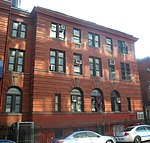The Hoyt–Schermerhorn Streets station (shown as "Hoyt-Schermerhorn" on official subway maps) is an express station of the New York City Subway, serving the IND Crosstown Line and the IND Fulton Street Line. Located at the intersection of Hoyt Street and Schermerhorn Street in Downtown Brooklyn, it is served by the A and G trains at all times, and the C train at all times except late nights.
Hoyt–Schermerhorn Streets was originally built as an interchange station between the Fulton Street and Crosstown lines of the Independent Subway System (IND). Construction of the station began around 1929, and it was opened to service on April 9, 1936. Hoyt–Schermerhorn Streets has six tracks and four island platforms, with two platforms and three tracks for each direction of service. The innermost tracks in each direction originally served Crosstown Line trains, while the center tracks were supposed to serve Fulton Street express trains and the outermost tracks were supposed to serve Fulton Street local trains to Court Street. However, Court Street was only served by a shuttle train from Hoyt–Schermerhorn Streets, which stopped running in 1946.
All Fulton Street Line trains currently use the center tracks in each direction, and all Crosstown Line trains use the innermost tracks, while the outermost tracks and platforms are not utilized for revenue service. Until 1981, the outer platforms were used by special trains to Aqueduct Racetrack, which stopped on the center tracks in each direction. Today, the abandoned tracks and platforms are only used on special occasions, such as for film shoots or moving trains to the New York Transit Museum at the former Court Street station. The mezzanine has also been used for film shoots, most famously for the video of Michael Jackson's single "Bad".










